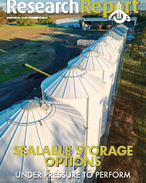This article is 3 years old. Images might not display.
Many pulse crops come with an increased fire risk because of certain characteristics of the residues and dust generated from the crop.
Chickpeas have high concentrations of malic and oxalic acid exuded from the fine leaf hairs, which causes the residues to stick together inside the harvester. This can lead to a build up of fine particles that are extremely combustible.
Lentils also have a very fine residue that can stick to the harvester and to dust particles. In addition, both these crops have pods very close to the ground so the header front is working virtually on the ground and can easily strike a rock, causing sparks to ignite the fine powder.
Peas, lupins and faba beans also have fine residue that powders easily and creates higher risk of ignition.
Pulse Australia and ACH recommend the best fire protection approach is to increase risk protection measures. And machine maintenance and machine hygiene are the two biggest factors to decrease fire risk.
Other risk-decreasing factors include initial paddock preparation to clear rocks and sticks and rolling the paddock to give an even, flat surface that is suitable for harvesting low to the ground.
Also, only operate harvesters when the conditions are favourable under the Grain Harvesting Code of Practice FDI 35.
Other tips include:
* Clean all cereal straw out of and off, every surface of the machine before starting in pulse crops. Pulse crop residue may smoulder. It's the cereal straw that will make the fire get out of control very quickly.
* Check under guards and covers for build up of dust and chaff.
* Check all knife guards and knife sections for damage or misalignment. Bent guards will cause heat build-up.
* Check bearings and moving parts for hot spots (use a hand held digital thermometer)
* Check the electrical system for worn cables (especially for rodent damage)
* Fix all fuel and hydraulic leaks.
* Use the battery isolation switch when the header is not in use.
* Locate fire-fighting gear close to the paddock. A small garden water sprayer located in the cabin can help extinguish small fires.
* Have a bare earth 'safe' area to park machinery for servicing.
* Train all staff in using firefighting equipment.
More details and tips to help reduce harvester fire risk can be found here: https://bit.ly/3kWMYDZ























